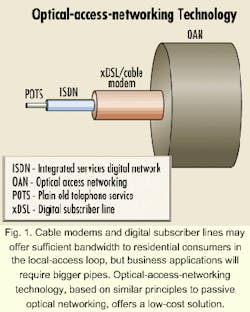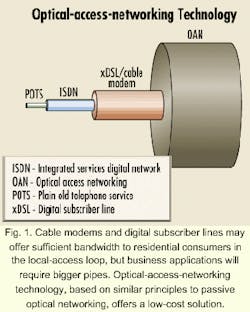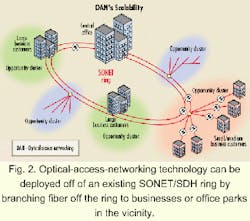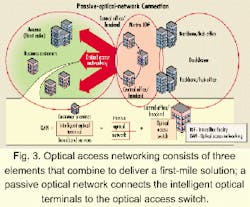The first mile at light speed
Already at the core of most wide area networks, optical technology will allow service providers to offer flexible bandwidth to a broader range of business customers in the local-access loop.
With the much-ballyhooed evolution of the public-network backbone to today's "big-fat-pipe" status, the future of communications services is "interactive." From here on out, we will be spoon-fed an all-you-can-eat diet of compelling, bandwidth-hungry applications such as interactive gaming, video-on-demand, and virtual reality that will increase our quality of life...right? Forget about it.
Without a similar focus on--and investment in--the first mile that connects users to the public network, delivery of 21st century services isn't going to happen. The result of this lopsided backbone build-out will be a ruinous price war between carriers, which threatens to eliminate many competitive service providers and, along with them, the enormous potential of next-generation services.
Without an effective way to economically deliver broadband services to the customer, service providers can achieve differentiation only by price-per-bit--a business model that is destined for failure. Only through the elimination of the first-mile bottleneck can service providers survive, and thrive, in this burgeoning communications market.
A new class of networking, referred to as optical access networking (OAN) offers a cost-effective solution. Based on the principles of passive optical networking (PON), OAN does not require the deployment of any electrical components in the path from the central office/headend to the business premises. Instead, the only outside-plant requirements (aside from fiber) are low-cost passive optical splitters and couplers. These passive elements enable the cost-effective fan-out of embedded or new fiber plant, using a branch and tree, or star configuration, to reach numerous businesses within a given geographic area. OAN can work in conjunction with Synchronous Optical Network/Synchronous Digital Hierarchy (SONET/SDH) and metropolitan wavelength-division multiplexing systems with "lambda routers," or serve as a viable alternative.
In its current state, the first mile is full of solutions claiming to provide answers to the business and residential-bandwidth dilemma. Foremost on this list are cable modems and several flavors of digital-subscriber-line technology. On the whole, these technologies have proven to be very effective for the residential market for users intent on surfing the Web, sending e-mail, and buying books, CDs, and toys online.
For the business user with more bandwidth-intensive needs such as virtual private networks, business-to-business e-commerce, Web and application hosting, and Web-based collaboration, these technologies do not offer viable long-term solutions. Like the optical evolution that has taken place at the core of the public network with optical add/drop multiplexers, lambda routers, and dense wavelength-division multiplexing systems, solution providers in the local-access loop must embrace optical technology as the gateway to the next-generation network (see Fig. 1).Today, SONET/SDH is the only game in town when it comes to the effective deployment of optical networking as a first-mile solution. In countless metropolitan areas, fiber-optic SONET/SDH rings are providing businesses with bandwidth capable of serving their broadband needs. This approach, however, has limitations. SONET/SDH represents a solution that fits, almost exclusively, the needs of large-business customers. The costs associated with the deployment of SONET/SDH are excessive for both service providers and business customers, making it a dubious alternative for companies not on the Fortune 500 list.
Another major drawback with the SONET/SDH architecture is its limited network scalability. SONET/SDH is most economical when deployed in rings. As a result, when the first competitive access providers arrived on the scene in the ྌs and started cherry-picking the largest buildings in metropolitan areas, the SONET/SDH ring-network architecture fit like a glove. At the time, companies in these large buildings were the most prolific consumers of bandwidth metropolitan access networks, which were planned and constructed with only a handful of buildings on each ring.
Today, those dynamics have changed. The emergence of a growing number of bandwidth-intensive small companies--such as Web design firms--indicates that the frantic consumption of bandwidth is no longer neatly contained within a ring comprising large businesses. According to a recent study issued by Vertical Systems Group, 76% of 235,000 businesses in the United States with more than 75 employees are located within one mile of an available source of fiber.
It is nearly impossible, or at the very least impractical, to add a new customer to an existing ring, however. A new customer usually means a new ring, which is anexpensive proposition. There fore, service providers face a frustrating dilemma; there is no feasible way to provision services to potential customers located in the shadow of theirexisting infrastructure.
Another limitation of SONET/SDH is the inability to offer flexible service levels. Service providers are un able to provision individual connection rates based on customer needs due to the inherent nature of this circuit-based technology. This situation locks business customers into an all-or-nothing cost structure that forces them to sign up for fixed chunks of bandwidth. The choice typically is between a DS-1 (1.5 Mbits/sec) or a DS-3 (45 Mbits/sec), which may or may not fit their business needs.
In contrast to SONET/SDH, which is priced so exorbitantly that it can only be deployed to serve the largest customers, OAN offers a solution at a price structure feasible for even the smallest businesses. Because it is based on a fixed-cost/low-variable-cost PON architecture, OAN can achieve cost points that are an order of magnitude lower than SONET/SDH, making it an attractive solution to serve the broadband service requirements of businesses of all sizes. From a bandwidth point of view, OAN provides business customers with access speeds equal to SONET/SDH, with the only real difference being the price of the service.
Beyond the significant first-cost benefits, OAN also promises lucrative savings in the outside plant. With more traditional sonet/sdh networks, classified as active networks, the presence of electrical components in outside-plant facilities is expensive for service providers because it requires constant electrical powering and limitless man-hours dedicated to ongoing maintenance. OAN is free of these issues.
In addition to the cost benefits, the OAN feature most compelling to service providers is its scalability. OAN can be deployed off an existing fiber infrastructure (e.g., a SONET/SDH ring) where the service provider has already invested considerable capital. By simply branching fiber off the ring to businesses or office parks in the vicinity, service providers can connect to commercial customers that they were previously passing, and to whom they were unable to offer services (see Fig. 2).OAN technology is also capable of slicing wavelengths so that a single lambda can serve myriad business customers in the same opportunity cluster or business park. This scalability vastly augments both the number of customers and potential revenue that can be derived from a given area. It also promises service providers the profitability that they will need to deploy next-generation services.
In addition to enabling the cost-effective deployment of an optical infrastructure to a larger community of business customers, the ability to offer customers flexible levels of service is another compelling aspect of OAN. OAN enables customers to choose virtually any access speed that suits their service mix. Through flexible allocation of bandwidth, utilizing Internet protocol (IP) and/or Asynchronous Transfer Mode (ATM), each customer on the OAN can select a service that specifically meets their bandwidth needs. This ability to support flexible service offerings eliminates the price gap between traditional DS-1 and DS-3 services, allowing providers to more effectively customize their offerings to meet the needs of a broader range of customers. With a new class of value-added and differentiated services in their portfolio, providers can improve their competitive position.
With the need for a first-mile bandwidth remedy a forgone conclusion, service providers will deploy optical-networking technologies in access networks to increase market share. This, in turn, creates a measure of bandwidth that leverages the enormous capacity already in place in the backbone, which will fuel further network expansion. OAN is the technology best suited to provide businesses with an affordable, high-bandwidth access solution tailored to each customer's network needs.
The public network is divided into three sections: backbone, metro, and access. While many optical solutions have been developed for the first two sections, optical technologies for the first mile are relatively recent and include a new class of optical-access-networking (OAN) products.
OAN consists of three elements that combine to provide a first-mile solution with unrivaled economic benefits and service delivery capabilities. An intelligent optical terminal, located at the business premises delivers a variety of broadband services and large amounts of flexible bandwidth-ranging from 1s to 100s of Mbits/sec--directly to business customers.
An optical access switch resides at the edge of the network in a central office, headend, or hub. The optical access switch aggregates, concentrates, and switches packet- and cell-based services from hundreds of intelligent optical terminals and provides the interface to the wide area network.A passive optical network (PON) connects the intelligent optical terminals to the optical access switch (see Fig. 3).
A PON is an extremely low-cost infrastructure with no active electronics that is capable of an enormous fan-out to many businesses. By eliminating outside-plant electronics and supporting high-bandwidth services, the PON-based access infrastructure is ideally suited to economically meet the exploding capacity requirements. It eliminates the outside-plant costs--maintenance, powering, and provisioning--that until now have deterred affordable fiber-to-the-business deployments.
Jeff Masucci is founder and vice president of engineering at Quantum Bridge Communications (North Andover, MA), a developer of optical-access-networking solutions.



